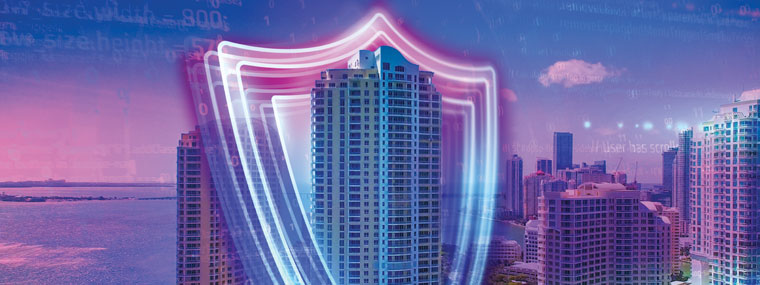
How Secure Is Your Community’s Network?
Here’s how to protect your residents and your property from data hacks
By John Von Stein / Published July 2023

Cybersecurity threats are a rising concern among consumers and businesses, and with good reason. A cyberattack happens once every 39 seconds—a number expected to increase as experts estimate that 1 million new pieces of malware (or computer viruses) are created each day.
With more people and businesses relying on digital devices and web-based software, cybersecurity poses a legitimate cause for concern and action.
How do you ensure safe network access for your community? How can you find a network solution that will address new data threats? It’s about choosing the right network architecture and service provider for your community and understanding best practices for protecting your data online. To make an intelligent decision, educate yourself about provider choices and be proactive about protecting your personal information.
Following are some of the questions about data security that are coming from Florida property managers and HOAs.
Question: Which digital network is most secure—cable or fiber?
Fiber-optic networks offer higher security compared to traditional cable networks. The following reasons explain why that is:
Physical security—Fiber-optic cables are more difficult to tap into than copper cables. Fiber strands transmit data as pulses of light, and any attempt to intercept the signal will likely cause noticeable disruptions, making it easier to detect tampering.
Immunity to electromagnetic interference–Fiber-optic strands are not susceptible to electromagnetic interference (EMI) since they transmit data using light rather than electrical signals. Cable networks, on the other hand, can be vulnerable to EMI, which can potentially be exploited for eavesdropping or data interception.
Longer transmission distances without signal loss—Fiber-optic strands can transmit data over longer distances without experiencing significant signal loss, unlike traditional cable. This makes it more challenging for unauthorized parties to tap into a fiber network and access data because there are fewer connection points to tap into.
Reduced signal leakage—Cable networks can suffer from signal leakage, where the transmitted signals can be unintentionally radiated and intercepted. Inherently, fiber-optic networks don’t have this issue, reducing the risk of a data breach.
Question: Are all fiber-network architectures the same?
No, there is a significant difference between fiber-network architectures. The top-of-the-line Active Optical Network (AON) architecture uses a direct, fiber-to-the-home (FTTH) design with no splitters. Two dedicated (private) fiber strands are run directly from the Main Demarc Frame (MDF) to each home or condominium unit, delivering uninterrupted signal strength for maximum performance and security. AON offers high bandwidth (for greater capacity), low latency (for faster speed), and the ability to deliver different services with flexible bandwidth allocation, making it ideal for properties with multiple units or end users.
Passive Optical Network (PON), on the other hand, is a shared fiber-network architecture. It uses a single fiber split to serve multiple subscribers using passive optical splitters. In addition to a frustrating, variable operating experience due to shared connections, there are inherent security risks associated with PON networks; because the data is commingled, it’s easier for hackers to access your private data.
So, while fiber is a more secure network choice than cable, the fiber-architecture type matters greatly. Be sure to ask questions of your prospective providers so that you know what you’re getting—insist on AON architecture to best position your residents to protect their personal property and information.
Question: QXC uses AON architecture, but what makes it “military grade”?
QXC has taken pride in serving U.S. military installments representing all branches of the armed forces since QXC’s inception. The U.S. government has incredibly stringent data network security requirements, and our AON architecture meets those lofty standards. According to CNET data, the U.S. military is the only sector that didn’t report a single data breach during 2021 (the most current data available).
Question: What’s the most common form of data hacking?
Phishing is the most common data breach. This is when someone sends a malicious link via email, text, or social media that looks legitimate but is designed to steal information or install malicious software when opened.
During the first half of 2021, about 75 percent of all cybersecurity attacks were made via email, most likely phishing. Social media channels are becoming popular for phishing scams because people are often more willing to trust the direct messages they receive on these platforms. So, beware of messages from individuals you don’t know. (For added protection, refer to the tips below.)
Question: How can I safeguard my data from hackers?
Protecting your personal information from hackers involves implementing secur-ity measures and best practices. Here are some steps you can take to protect your personal data:
- Use strong, unique passwords—Using the minimum 8-character password with upper and lowercase letters takes a hacker 28 seconds to break your password. Adding numbers and special characters increases the hack time to 5 minutes. Ext-ending that password to 10 characters increased the hack time to 2 weeks. So, while small changes materially increase hack time, the best security is keeping the hackers from getting your information in the first place. And AON is the best fiber architecture accordingly.
- Enable two-factor authentication (2FA)—This adds an extra layer of security by requiring a second form of authentication, such as a verification code sent to your mobile device.
- Keep software and devices up to date—Regularly update your operating system, applications, and devices with the latest security patches to help protect against known vulnerabilities that hackers may exploit.
- Be cautious of phishing attempts—Be vigilant about email and online communications. Avoid clicking on suspicious links or downloading attachments from unknown sources. Be wary of phishing attempts, where attackers trick you into revealing sensitive information by impersonating trustworthy entities such as retailers or banks.
- Use secure Wi-Fi networks—Be cautious when connecting to public Wi-Fi networks. Use encrypted networks or a virtual private network (VPN) to encrypt your internet traffic and protect your data whenever possible.
- Encrypt sensitive data—Consider encrypting sensitive data stored on your devices or in the cloud. Encryption converts your data into an unreadable format, making it harder for unauthorized individuals to access it.
- Back up your data regularly—Use an external hard drive, cloud storage, or another secure location to back up important data. Then, in the event of a security breach or data loss, you can restore your data from backups.
- Adjust your social media privacy settings—Review and realign your settings to limit the personal information you share publicly. Hackers can use it for social engineering attacks or identity theft.
- Use reputable security software—Install and regularly update antivirus and anti-malware software on your devices. This helps detect and prevent malicious software from compromising your data.
- Educate yourself about online threats—Stay informed about the latest cybersecurity threats and how to protect against them.
Approximately 11.7 million Americans are hacked each year. So, to protect yourself and your residents, stay informed and vigilant. The type of digital network architecture you choose for your community is essential in creating a safe, secure digital environment.
Beyond choosing the best infrastructure, consider holding regular seminars for residents about detecting and protecting from the latest cyberthreats. Our team at QXC is happy to help.
John Von Stein
President, QXC Communications
John Von Stein is president of Boca Raton-based QXC Communications, a network engineering firm that designs and deploys fiber-optic networks that deliver managed Wi-Fi/internet, HD-TV, and VoIP phone service for COA/HOA properties and businesses. For more information, connect with him at 561-708-1500 or sales@qxc.us, or visit QXC online at www.qxc.us.




